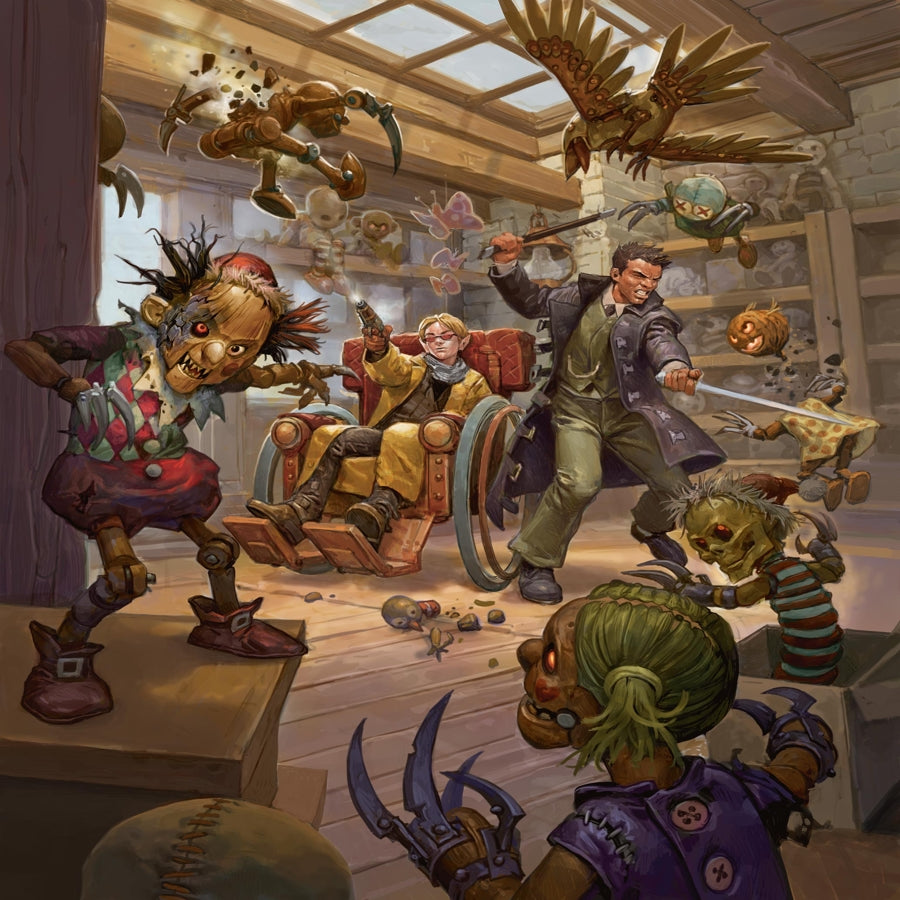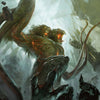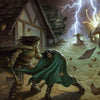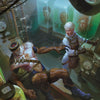My Homebrew RPG Initiative System

Written by Luke Hart
Today, we’re going over my homebrew initiative system. There are tons of initiative systems out there for DMs to use—I’ve experimented with a few of them myself—so I imagine you might be asking yourself, “Luke, why should we care, and what makes your system any better?”
This article will have two parts. In part one, I’ll explain how my initiative system works. In part two, I’ll cover the system’s advantages and disadvantages, which I’ve discovered while play-testing it with a few D&D groups. That part will address why you should care and why you might want to try it out at your D&D games.
However, I will tell you this upfront: My system makes tracking initiative far easier for the dungeon master and helps speed up combat. As I understand it, those are the two things most folks are fairly interested in.
By the way, if you’re a new dungeon master feeling a bit overwhelmed by everything involved in running a D&D game, I completely understand. That’s why my team and I made Lairs & Legends.
With over 700 pages of adventures, monsters, puzzles, traps, and other 5e GM resources, Lairs & Legends gives you all the resources you need to remove some of the frustration from being a GM. With this horde of ready-to-use game elements that can be quickly dragged and dropped into your game, you can reduce your prep time and still run amazing games for your players!
Watch or listen to this article by clicking the video below.
Let’s get back to that initiative system, shall we? As promised, I’ll explain how it works in five easy steps and then give you an example.
Step #1
One player and the dungeon master roll initiative. The player with the highest initiative modifier rolls and the DM rolls using the highest Dex modifier of the different types of monsters they’re using in the encounters.
Step #2
Whichever side wins goes first—sort of. If the player wins initiative, two players get to take their turn. If the DM wins, one monster group or type takes its turn.
Step #3
The other side goes. If two players have already gone, the DM takes the turn of one monster group or type. If the DM has gone first, two players take their turn.
Step #4
Keep rotating turns between two players or one monster group or type. The rest of the combat plays out the same way. Two players take their turn, then one monster type, then two players, then one monster type, until everyone has taken their turn.
Step #5
The players get 1 minute before the next round begins to discuss tactics. Then, we rinse and repeat, starting with step 1.
Some important notes. First, when it’s time for two players to take their turn, any player can go; it doesn’t matter which one. Let the players decide and have that be part of their combat tactics. My only stipulation is that whoever wants to go already knows what they are doing and is ready to take their turn. No waiting 10 minutes for the wizard to pick out their spell, thank you very much.
Second, you may have noticed that rolling initiative is only important for determining which side goes first. After that, there is no initiative tracking or a precise order. As long as turns rotate between two players and one monster group or type, that’s all you need to keep track of.
Finally, the dungeon master must determine whether they want to break the monsters up by groups or types. For instance, if I just have a mob of 20 goblins, I might break them up into two groups of 10 each or three groups of roughly 7 each. Then, those groups would get their turns between the players’ turns.
However, if I had goblin fighters, goblin archers, and a goblin boss, I would probably break the monsters up by type. So, after two players go, all the goblin archers shoot. After two more players go, all the goblin fighters charge in. Then, after another two players go, the goblin boss takes its turn.
The hallmark of this system is simplicity and speed, not rules and bogging things down. If you’re looking for that, I suggest you try the Grayhawk Initiative System.
Example
Let’s go over a quick example to illustrate how this works by pitting five PCs against a group of hobgoblin warriors, some hobgoblin wizards, and a few hell hounds. First, one player rolls initiative (usually, the player with the best initiative does it), and the dungeon master rolls initiative. The player gets the higher roll, so two players take their turns. In this case, Robby, the wizard, decides to cast fireball—really original move there— and then Dalinor, the paladin, charges in to attack the hobgoblin warriors.
At this point, two players have gone, so one of the monster groups gets to go. The dungeon master decides to group them according to their types and has the hobgoblin wizards all drop some fireballs on the heroes. Monkey see, monkey do, right?
Now that one monster type has gone, two more players get to go. Rudolf, the halfling druid barbarian, Rages, shapeshifts into a polar bear and charges the hobgoblin wizards. Then Grisst, the min-maxed, OP hobgoblin/ranger/rogue, Stealths up to the hell hounds and murders one of them.
Now it’s a monster type’s turn. The hobgoblin warriors lay into Dalinor with their swords, and one charges Nigel, the bard, seeing him vulnerable in the back lines.
Now, the final player gets to go. Normally, two players could go, but only five are in the group, so just the one remaining player goes. Nigel freaks out over the one hobgoblin warrior charging him, casts greater invisibility, and runs to hide.
Now, the final monster type gets to go. The remaining hell hound breathes fire on Grist, the min-maxed, OP hobgoblin/ranger/rogue. Normally, this would be a Dexterity saving throw, but the DM has a vendetta against Grist, the min-maxed OP hobgoblin/ranger/rogue, so he calls for a Constitution saving throw instead.
At this point, they have had one round of combat, and everyone on the battlefield is moderately wounded. Now I have a house rule that gives my players one minute between rounds to discuss tactics for the next round, so I’d tell them “discuss” as I flip over the 1-minute sand hourglass.
When the minute is up, I have one player roll initiative, I roll initiative, and it’s time to rinse and repeat. That’s right; we re-roll initiative for every round with this system.
Benefits
#1 Combat Moves a Little Faster
They probably aren’t exponential gains in speeding the game up, but it does help. Why? With the normal initiative system, you know what it’s like when it’s the wizard’s turn, he still hasn’t decided which spell to cast, and everyone has to wait for him to think and flip through the PHB, only to end up casting fireball anyway?
Well, with this system, when it’s the players’ turn, only ready players can go. If the wizard hasn’t figured it out yet, he just waits until later in the round to go instead of holding the entire game up. Come on, I can’t be the only one who gets triggered by wizards and other spell casters doing this, can I?
#2 Tracking Initiative is Easier for the Dungeon Master
Benefit number two is it makes tracking initiative easier for the dungeon master. They no longer have to write it down, read it off, skip players by accident, then get corrected and have to go back to Robby, the wizard, who missed his turn—not that I would ever accidentally or intentionally skip a player’s turn.
I mean, I’ve never found tracking initiative to be that big of a challenge, but I remember reading some Reddit posts or something about people finding it to be extremely challenging. If you find tracking initiative difficult, my system fixes it.
#3 Player Freedom
The third benefit is player freedom. The players are no longer confined by a rigid turn order. They can take their turns in whichever order they want. This helps them decide tactics and, honestly, is a little more realistic when you consider that in a six-second combat round, everything is supposed to be happening simultaneously anyway. So, it makes sense to be less strict with turn order.
#4 Tactics Discussion
The fourth benefit is the one-minute tactics discussion between rounds. It helps them decide which order they’d like to go in on the next round and cuts down on tactics discussions in the middle of the round, speeding things up.
Trust me; this tactics discussion between rounds is just hugely beneficial for your players. They will appreciate having it.
#5 More Dynamic and Interesting Battles
Your battles will be more dynamic and interesting when the order in which everyone goes changes from round to round. Having a fixed turn order in a three- to seven-round battle is incredibly boring, in my opinion. It’s so much more interesting and fun when it changes constantly.
Now, you could get that benefit by using the standard initiative system and having your players re-roll initiative every round. I’ve actually tried that, and I did like it—sort of. Having a fresh order for each round was great, but re-rolling initiative each round and then having to mark down everyone’s new order was boggy, and I didn’t like it.
#6 Interspersed Monster Attacks
In my opinion, it is boring as crap when all the monsters take their turn at once. Integrating the monsters’ turns among those of the players is far more dynamic, interesting, and fun. I could deep-dive into reasons, but for the sake of staying on topic, I’ll just ask that you trust me.
Drawbacks
Like any system, this one also has a couple of drawbacks. Let’s go over them.
#1 Minor House Rules
If your players begin to game the system and make it OP, you might need to make some minor house rules. For instance, let’s say you have a squishy monk PC whose only redeeming quality is stunning strike (Thanks, Wizards of the Coast). That monk could go first on a round and then run up and stun the Big Bad Boss, allowing all of the other players to pile on and wallop them.
On the next turn, the monk decides to go last because the stun lasts until the end of their turn. This allows all the other players to wallop on him some more before it’s the monk’s turn again. With the standard initiative system, they wouldn’t get to double-dip like this.
So, it’s either house rule something (not my preference) or ask your players not to game the system and break it for everyone. Alternatively (and this is an option for particularly devious dungeon masters), you can have your monsters game the system the same way as your players.
There’s a saying for that. Fight fire with fire—give them a taste of their own medicine—or something like that.
#2 High-Initiative Players
The next drawback is that some players build their characters for high initiative. This system doesn’t let them take advantage of that so much. One player will definitely benefit from high initiative if they are rolling for the group each round, but any other players won’t.
Now, I’m not just talking about characters who would have high initiative anyway because they are Dexterity builds—rogues, rangers, classes like that. I’m talking about a player who takes something like the Alert feat with the expressed desire to improve their initiative bonus.
Basically, for players who build their characters for high initiative, I would just give them a do-over, a mulligan. They can swap out that feat or redesign their PC a bit to account for the new initiative system we’ll be using. I feel like that’s the only fair thing to do.
Get Loads of 5e Adventures and Resources for Your Games!
When I was a new dungeon master, I was overwhelmed with everything I needed to do. Learn the rules, create the adventures, run the game, handle problem players—it was A LOT! And even as a veteran DM, it’s still a lot. You might even feel that way yourself.
If you’re looking for loads of 5e adventures that you can prep in under 30 minutes, or elements such as traps, puzzles, and encounters that you can drag and drop into your game at moment’s notice, we have you covered!
With Lairs & Legends and Loot & Lore, you’ll get over 700 pages of 5e resources:
- Twenty-nine 5e adventures spanning levels 1 to 15 and designed for groups of 4 to 6 players.
- Over 100 new creatures from CR 0 to CR 24.
- Adventure Ideas
- Encounters with Full-Color and Blackline Digital Maps
- Patrons & Factions
- Magic Items
- NPCs
- Puzzles
- Random Encounter Tables
- Random Tables
- Spells
- Subclasses
- Traps
- Villains
Everything is designed to be EASY TO USE and QUICK TO PREP for your game. Our goal is to make game masters’ lives easier, not more complex!
-
Posted in
Game Master How-To Articles







